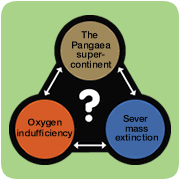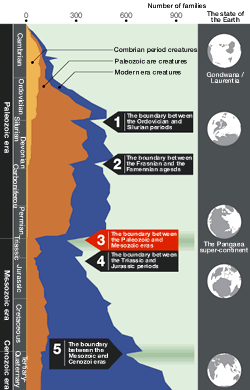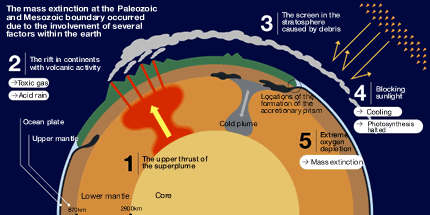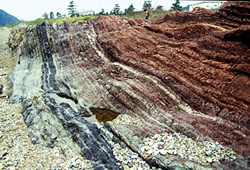| Research: Index > Sever mass extinction -Accelerator of evolution |
| Narrative science Sever mass extinction Accelerator of evolution | |
| |
| The Phanerozoic period, which began more than 550 million years ago, is divided into the Paleozoic, Mesozoic, and Cenozoic eras. The lines of demarcation for each are the period of extinction within a short time for different organisms that lived in different environments on the earth. Thus, the simultaneous extinction of large animals and plants, as well as finfish and plankton in the seas, is known as a mass extinction. There have been five of these mass extinctions in the Phanerozoic period, with the largest occurring at the end of the Permian during the Paleozoic era 250 million years ago. It is estimated that nearly 90% of the invertebrates that lived in the sea at this time were exterminated. In fact, three major events, each unique in the Phanerozoic period, occurred simultaneously at this time. The first was that the Pangaea supercontinent was formed and immediately began to rift. The second was the long-term oxygen insufficiency in the seas. The third was the largest extermination in history. Research has progressed on the assumption that the discovery of a relationship of cause and effect among these three events would unravel the mystery of demarcating the Paleozoic and Mesozoic eras. |
| The five mass extinctions of the Phanerozoic period | |||||
|
 |
||||
|
| A superplume is the large mantle flow that upwells toward the Earthユs surface, with a continent rift accompanied by a large eruption. This releases a large quantity of noxious gas as a result, and acid rain falls. In addition, debris from the eruption spreads throughout the atmosphere and blocks out light from the sun. This causes significant change on the earth, including halting photosynthesis and cooling the climate. This in turn is believed to result in long-term oxygen insufficiency and mass extinction. The mass extinction eliminated many living creatures, but new species were later born. The earth is not a gentle planet for living creatures, including humankind, but at the same time, it is a wonderful planet of vitality that continually creates new creatures. We would like to view the earth and the history of life in this way. |
|
Most of the ocean deposits from more than 200 million years ago are not on the surface because they were carried by the plates and sunk into the ocean troughs. When they sunk, however, part of the plate’s surface was peeled away and stuck to the continental land mass. This is called the accretionary prism. The world’s first discovery of ocean deposits from the boundary of the between the Paleozoic and Mesozoic eras was made in the accretionary prism of western Japan. A chemical analysis shows a lack of oxygen in the seas for about 20 million years. I refer to this as The Great Oxygen Depletion. |
| ||
|
|
Mechanism of symbiosis Gene network made up of plants and soil microbes | ||
|
|
Observation and expression | ||
| Rsearch |
|
Please close a window with the button of a browser who are turning off Javascript. |


